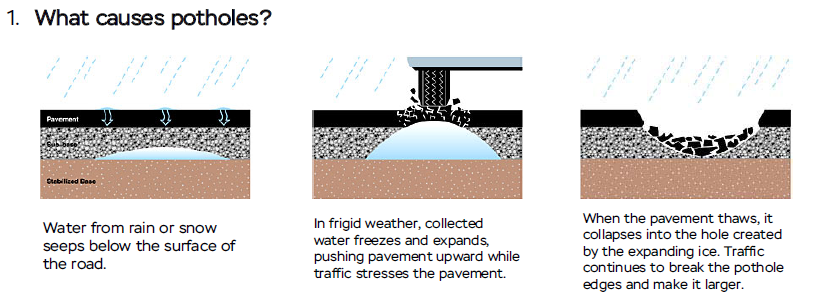Potholes
Potholes aren’t just a nuisance for drivers; they constitute a dangerous safety hazard that can produce substantial damage to vehicles, force drivers to veer suddenly in traffic, or even cause the driver to lose control of a vehicle after contact.
Frequently Asked Questions
What causes potholes?
Many factors may contribute to the creation of potholes. Potholes form when water becomes trapped beneath the pavement surface. As vehicles run over the saturated base material, the unsupported surface layer collapses resulting in a hole. The pothole expands as traffic hits the hole.
Water enters the road base through surface cracks or from the sides of the road. During the winter the water freezes, drawing more water into the base material. The February and March freeze‐thaw cycles often cause frost heaves, which let in more water. The ice melts from the top down, leaving a trapped pool of water.
Water, salt and ice are enemies of concrete and asphalt. Water seeps below the road surface. When water freezes, the expansion and contraction that occurs may disturb the structural integrity and foundation which may lead to cracks on the surface of the road. With the passage of time and the weight of vehicular traffic, the cracks may gradually become a pothole.

What are the two primary methods for patching potholes? What factors determine which is used?
Cold and Hot patch procedures. Depending on the time of year, the average daily temperature and anticipated weather conditions, a temporary or permanent patch will be installed.
Water from rain or snow seeps below the surface of the road. In frigid weather, collected water freezes and expands, pushing pavement upward while traffic stresses the pavement.
When the pavement thaws, it collapses into the hole created by the expanding ice. Traffic continues to break the pothole edges and make it larger.
The procedure is not as simple as pouring in the filler, patting it down and driving away, is it?
The maintenance crew must accurately assess the type of pothole, evaluate the size of the affected area and determine the primary cause of the hole. Members of the crew may use a saw or jackhammer to “square up” the affected area. The next step is for the crew to use a wire brush, hot lance or air compressor to make certain the area is clean and dry so the patch material will take hold. The entire process may take less than an hour or most of a day depending on the size of the pothole and the reasons it occurred.
Do SHA trucks routinely carry materials to repair potholes?
Temporary cold patch mix material is usually carried on many SHA trucks especially in the early spring when potholes are likely to occur.
Many Possible Causes for Potholes
Changes in temperature, water, and aging may begin with a small hole or simply with the road surface cracking. The more vehicles that travel over it, the larger it will become. For temporary repairs, a cold mix is available (**) often carried on SHA Maintenance trucks. Crews can quickly fill and patch potholes – but the repair only lasts about a month and then it begins to break down.
To properly repair potholes crews must examine and determine how extensive the damage is. The crews may use a jackhammer and saws to “square up” the affected area. The pothole may be a two or three‐foot square portion to be repaired. The crew must be sure the area is clean and dry when new asphalt or concrete is installed. Crews use hot lance, air compressor, wire brush and other tools to completely clean affected area.
**The cold mix is easier and more convenient to use but takes longer to set up – contains more oil than hot mix.
Concrete
Below the surface there are steel bars or wire mesh material made of metal. Sodium chloride comes into contact with metal and the result is a chemical reaction which can produce powerful force- up to 10 times the strength of concrete. This ultimately causes concrete to crack and develop potholes.
Asphalt
Oxidation occurs as a natural part of the aging process. Oils in asphalt dry out, leads to cracking. Original asphalt mix may vary depending upon when the surface was laid. Specifications for bituminous concrete (asphalt) have changed over the years as the process has been improved – based on research and testing.